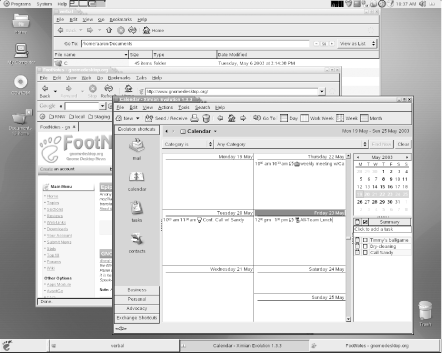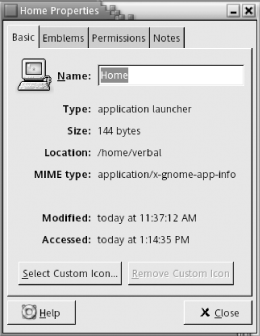
Chapter 17. GNOME
Contents:
Desktop Overview
The Panel
The GNOME Menu and the Menu Panel Menus
The GNOME Control Center
History and Changes in GNOME 2
One of the two popular desktop environments used with Linux, GNOME is provided as the default desktop for Red Hat, Debian, and several other popular distributions. As a graphical environment, GNOME provides users with a highly customizable user interface and consistent functionality of common GUI features such as menus, toolbars, and buttons. In addition, it offers users a growing set of native applications to create a productive computing system. The number and quality of applications are a testament to the developer-friendly GNOME libraries; many GNOME technologies are also used in nongraphical or totally unrelated software. GNOME is distributed with most Linux distributions, and you can also get it from the GNOME web site (http://www.gnome.org) or from Ximian (http://www.ximian.com), a company that specializes in the GNOME desktop.
GNOME stands for "GNU Network Object Model Environment," and although the name is admittedly obscure, it does point to one of GNOME's core technologies: its CORBA-based objects. CORBA (Common Object Request Broker Architecture) specifies methods that allow interaction among applications through the sharing and embedding of component objects. For example, a spreadsheet created by Gnumeric (a GNOME spreadsheet program) can be placed as an object into an AbiWord document, and the Nautilus file browser can display images, web pages, and so forth by embedding an image viewer and HTML display engine. GNOME uses two libraries to do this: ORBit, (http://orbit-resource.sourceforge.net), which provides an Object Request Broker (ORB), and Bonobo (http://developer.ximian.com/articles/whitepapers/bonobo), which is designed to simplify the task of creating reusable software components and compound documents.
This edition of Linux in a Nutshell covers a GNOME desktop based on the GNOME 2 platform, which is included in Red Hat 8.0, Mandrake 9.0, and SuSE 8.1, among other distributions. The new platform differs from the previous version, GNOME 1.4, in a number of significant ways. Overall, the new platform has brought increased performance and stability, more coherent and powerful developer tools, and a friendlier, simpler interface.
You do not need to be familiar with earlier versions of GNOME to use GNOME 2. If you are familiar with earlier versions and want to know what's new, or if you are curious about the history of the project, see Section 17.5 at the end of this chapter for additional background information.
17.1. Desktop Overview
Figure 17-1 shows the default GNOME desktop. The left side of the screen contains icons that are shortcuts to open applications, files, or URLs. The top icon is a link to the user's home folder; when double-clicked, it launches the Nautilus file manager to display the folder's contents. The other icons include shortcuts to the floppy drive and CD-ROM and links to web pages. In general, double-clicking on an icon leads to the most logical operation, so clicking folder icons displays folder contents, clicking application icons launches applications, and clicking a file opens the file in its most appropriate application (see Section 17.4.4.2 for information on how to choose which one). A button or icon you can press to start an application is called a launcher. You can drag and drop the icons around the desktop to arrange them as you like, or drag them onto the Trash icon to get them out of your way.

Figure 17-1. The GNOME desktop
You can also right-click on any blank space in the desktop and get a context menu that allows you to:
-
Open a new file manager window.
-
Create a new folder.
-
Create an application launcher.
-
Open a new terminal window.
-
Run scripts or executable files you place in your scripts folder (~/.gnome2/nautilus-scripts).
-
Clean up the icons on the desktop.
-
Copy, paste, or cut selected files.
-
Change your desktop background.
-
Display the contents of any mounted disk in the file manager.
The bars across the top and bottom of the screen are called panels. Some distributions and configurations use only one, and others use more than two. GNOME allows you to create a variety of panels and choose their placement, size, and behavior. The one at the top, called the menu panel, is perhaps the most common and important. It may be slightly different in some distributions of GNOME, but it generally consists of two menus on the left, and a clock and application switcher on the right. Some systems may also include other small applications, called applets; see Section 17.2.3 for more information.
If you do not have a menu panel, the desktop probably offers the GNOME menu, which is similar to the Start menu in Microsoft Windows. On most systems, it appears in the lower left corner and is designated with a GNOME foot logo, earning it the nickname "the foot menu." In Red Hat 8.0, click the red hat to get the same menu with a list of applications, help, and a few other tools, plus the logout and screen-locking tools. If you want to add this GNOME menu to a panel, right-click on any blank space in the panel and select Add to Panel → GNOME Menu.
In general, the panel is a primary means of finding and opening applications and managing your desktop. You can add buttons to the panel to launch any application on your system; you can also include small applications, called applets, in the panel. For more information, see Section 17.2.
GNOME allows you an enormous number of configuration options for your desktop environment. You can right-click on just about anything and get a pop-up menu (called a context menu) containing specific actions for that item and a way to configure its properties. General configuration settings are contained in the GNOME Control Center. You can access this tool by selecting System and then Settings in your menu panel (on some systems, look for Desktop Preferences under the Programs or Applications menu). For more information about settings, see Section 17.4.
17.1.1. Adding Desktop Icons
Desktop icons offer convenient double-click access to your most important files, applications, and links. The items displayed on your desktop exist as files in the .gnome-desktop directory of your home directory. Anything you add to that directory will appear on the desktop.
To add an icon that launches an application, select New Launcher. This opens the Desktop Entry Properties dialog box as shown in Figure 17-2. Provide the name of the launcher (this will be the text displayed underneath the icon), a comment (the tooltip that appears when the pointer is over the icon), and the command used to run the application. After you click OK, the new launcher icon appears on your desktop.

Figure 17-2. Desktop entry properties
A convenient use of desktop icons is to provide shortcuts to frequently used files or folders. Adding shortcuts is easiest from the file manager (Nautilus). Display the directory containing the item for which you want a shortcut on your desktop, right-click on the item, and select Make Link. Then click on the new link and drag it to the desktop, which has the underlying effect of moving it to your ~/.gnome-desktop folder. You can copy an item instead of moving it by pressing the Ctrl key while selecting and dragging the item.

Copyright © 2003 O'Reilly & Associates. All rights reserved.



